If you’re not familiar with dan dan noodles, or if you’ve had this fiery, aromatic and addictively savoury snack in a restaurant but never made it yourself, this column will change your life. Named for the cry of the itinerant vendors who once roamed the streets of Chengdu with the tools of their trade slung on a bamboo pole – or dan – across their shoulders, dan dan noodles, as Fuchsia Dunlop explains, are traditionally served in small portions, “just enough to ease the hunger of scholars working late or mahjong players gambling into the night”, and should be eaten quickly, while the noodles are still hot and the fried topping crisp.
Liberally laced with the smoky chilli oil and numbing pepper for which Sichuan province is famous, they’re a fabulous winter warmer, and the ideal supplement to your Chinese New Year feast, should you be celebrating, noodles being a traditional symbol of longevity. Polish off a couple of tangerines for luck afterwards, and the Year of the Dog is sure to be a good one.
The noodles
The dish ought to be made with fresh flour-and-water noodles, painstakingly pulled by hand, a process helped along by the addition of a strong alkaline solution – and a lot of patience. Thankfully, none of the recipes I find suggests attempting to make your own, though if you do have a yen for an upper body workout, chef Andrew Wong has a 12-step guide in his excellent A Wong cookbook, which helpfully also includes instructions for what to do if you lose the will to live.
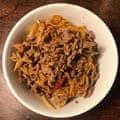
Dunlop calls for “dried Chinese noodles” on the basis that simple flour-and-water versions aren’t available fresh in this country, advancing fresh egg noodles as a substitute, but since her book Sichuan Cookery was first published in 2001, we’ve become rather more adventurous, and I don’t have much trouble tracking down fresh, eggless noodles in my local Chinese supermarket. That said, I am lucky enough to have a local Chinese supermarket – if you can’t find the thin, fresh kind, Helen and Lise Tse recommend fresh udon in their A Chinese Street Food Odyssey, and MiMi Aye’s book Noodle! uses Shanghai noodles, which seem to be thicker than the standard sort.
In fact, almost any fresh wheat flour and water noodle will do – steer clear of the dried or egg varieties, which don’t give such good results, and cook them at the last minute, so they’re as hot and slippery as possible when they hit the bowl. (The New York Times’ rationale in refrigerating the cooked noodles before use is a puzzle, but if you do want to cook them ahead of time for some reason, give them a dash of a little sesame oil to stop them clumping together.)
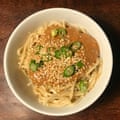
The meat
Meat plays a fashionably minor part in this recipe – a crunchy, savoury garnish, rather than the star attraction. Pork seems to be traditional, but Dunlop, who lived in Chengdu for two years and studied cookery there, supplies a recreation of a “legendary and unique” beef-based version at a tiny restaurant near the city’s university; BBC Good Food, meanwhile, uses turkey, while J Kenji López-Alt keeps things vegan with mushrooms, cooked very slowly until “dehydrated, lightly shrivelled, and deeply browned… [with] a flavour that is not really pork-like, but savoury and rich in its own unique way”.
The testing panel favours pork, whose fatty richness works better with the hot, sour flavours in the sauce, though non-pig eaters can make the swap to beef with a clear conscience, because both appear to be acceptable in the dish’s homeland. However, if you’d prefer to keep it entirely meat-free, go with López-Alt’s clever fungi fix, which wins plaudits all round. As long as you cook whatever it is in plenty of very hot oil, so it crisps up (groundnut or vegetable; sesame has too low a smoke point), you’ll achieve the desired effect. To leave the topping off entirely, as in the New York Times recipe, is to strip the dish of one of its key elements.
Stir-fry ingredients
That topping should have a bit of a kick, and tingly Sichuan peppercorns are vital for their peculiar, numbing heat. (If you can’t find them sold separately, the more widely available Chinese five-spice powder, as used by the Tses, will contain them, along with sweeter spices such as ginger and cloves, but you’ll struggle to get quite the same effect.) Roasting before grinding will bring out the pepper’s full flavour – Dunlop also uses the corns whole in her take on Xie Laoban’s version, which most testers find rather overpowering, though pepper fiends may wish to give this a try; Aye simply uses them to infuse the cooking oil, which proves too subtle.

The same goes for chilli heat: Dunlop prefaces her recipe with the warning that “these noodles are not for the faint-hearted”, and she’s the only person to call for whole Sichuan chilli peppers – also called “facing heaven chillies” – in her stir-fry. These are easier to track down than they once were; rounder and slightly milder than dried Thai chillies, and can be added to the pan at the same time as the pepper to impart some extra poke.
Though you can add ginger or garlic at this stage, if you wish, and many recipes do, the vital vegetable element comes from ya cai, or preserved mustard greens: salty, pungent and slightly spiced, they add an unmistakably funky element to the dish. If you can’t find them, Tianjin preserved vegetables, sold in squat earthenware jars, make a decent substitute, but they’re not exact counterparts, so it’s worth hunting down the proper stuff if you have time; it keeps almost indefinitely, so it’s not a bad investment. If both prove elusive, I wouldn’t advise using gherkins as the Tses recommend; they’re far too vinegary. Instead, López-Alt reckons that a mix of kimchi and salted capers is the best alternative (kimchi is available in larger mainstream supermarkets these days).
Because the vegetables are salty, go easy on the soy sauce here: just a dash is sufficient, along with some rice wine (use dry sherry, as Aye suggests if you don’t have this).
The sauce
This crisp, salty topping is paired with a hot, sour sauce, fiery with chilli oil and tangy with black vinegar. Many recipes advise making the chilli oil yourself, which is an excellent idea if you’re thinking a couple of days in advance; all you need are some Sichuan chillies and groundnut oil. If not, it’s readily available in specialist Chinese stores; look for the stuff with the chilli flakes in, rather than the bottles of clear red oil. The heat will vary according to brand, which is why I recommend adding it to taste, rather than sticking it all in in one go and repenting at leisure.
Sesame paste is a popular addition, but don’t use Middle Eastern tahini, as López-Alt suggests: the seeds for that aren’t roasted before use, so it tastes surprisingly different. Peanut butter is a better stand-in for the deep, nutty flavour of the real thing. That said, delicious as the New York Times’ thick, peanutty sauce is, it doesn’t taste anything like any version of this dish I’ve ever had, and the testers decide they prefer the sauce without either: “It’s punchier.” Vinegar is the other must, preferably rich, savoury black-rice vinegar, though you could use the lighter variety if that’s all you have in the pantry. I’m also going to add a pinch of sugar – not traditional in the dish’s home region, it seems, but almost all the recipes I try call for it, and with good reason: it rounds out the flavours of the sauce nicely, particularly in the absence of sesame paste. Feel free to leave it out if you don’t think it needs it.

The Tses add chicken stock to their sauce, while López-Alt adds a dash of the noodle cooking water to his vegan version, on the basis that, “traditionally, the sauce base gets mixed with some rich chicken stock, which adds some natural gelatin and body to the mix. Plain old water or vegetable stock are lacking in that body, making the sauce a little too thin”, while “the extra dissolved starch” in the cooking water thickens the sauce, binding it and helping it cling better to the noodles”. I don’t find any other recipes using stock, but I do find there’s not enough sauce in Dunlop’s recipe to coat her noodles. A slightly looser consistency seems desirable, and a splash of noodle cooking water does the job perfectly.
Serving and garnish
Dunlop informs the reader that to serve the noodles Sichuan style, “divide all the sauce ingredients into individual bowls, top each with a portion of noodles and scatter with a little cooked meat”. Make sure you serve it immediately, so it can be tossed together by the diner before the noodles clump together.
Little extra garnish is needed, but a few crisp spring onion greens add a welcome touch of freshness – so the white parts don’t go to waste, I’m adding them to the stir-fry. Some recipes finish the dish with coriander, but the testers aren’t keen on its soapy flavour in this instance – much better, the braver ones reckon, to dribble over a little extra chilli oil, as Aye suggests. Proceed with caution.
The perfect dan dan noodles
Prep 10 min
Cook 20 min
Serves 2
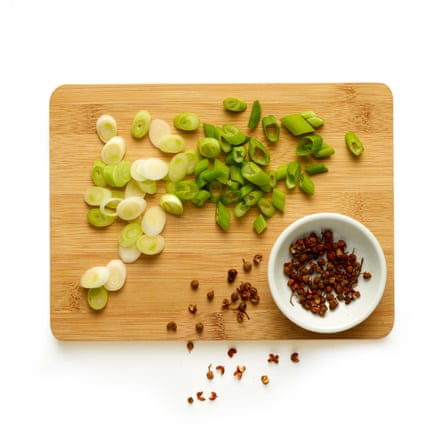
1 tsp Sichuan peppercorns
1 tbsp groundnut oil
100g minced pork
1 tbsp preserved Sichuan ya cai (Tianjin preserved vegetables), finely chopped
2 spring onions, sliced diagonally, whites and greens separated
1 tsp Shaoxing rice wine
1 tsp light soy sauce
175g fresh flour and water noodles – fairly thin ones, ideally
For the sauce
4 tbsp light soy sauce
2-4 tbsp Sichuan roasted chilli oil, with sediment (to taste)
2 tsp Chianking black rice vinegar
½ tsp white sugar (optional)
Toast the peppercorns in a dry, hot wok or frying pan until fragrant, then grind and set aside.
Heat the oil in a frying pan or wok over a high heat until shimmering, then add the pork and stir-fry until brown and beginning to crisp. Add the preserved vegetables, the whites of the spring onions and the ground pepper, and stir-fry for a couple of minutes. Add the wine and soy sauce, and continue to cook until dryish and crunchy.

Whisk together the ingredients for the sauce in a heatproof bowl, adding two tablespoons of chilli oil at this point.
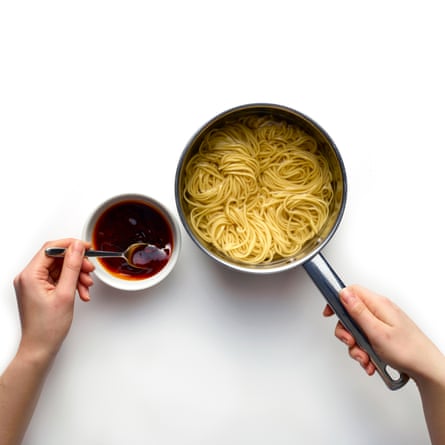
Cook the noodles in just enough boiling water to cover until springy, then scoop out a cupful of cooking water and set aside. Drain the noodles.
Whisk four tablespoons of cooking water into the sauce, then taste and add more chilli oil, if you think it needs it. Divide between bowls, add the noodles and sprinkle over the pork and spring onion greens. Serve immediately, with extra chilli oil on the side.
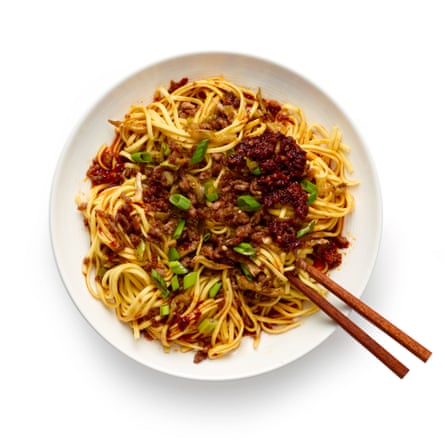
Are dan dan noodles the quickest, easiest Chinese noodle dish around, or do you have other suggestions for the new year feast?
- Food styling: Iona Blackshaw
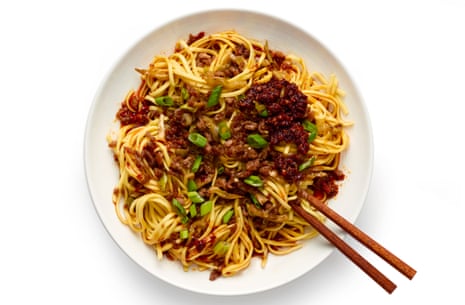
Comments (…)
Sign in or create your Guardian account to join the discussion